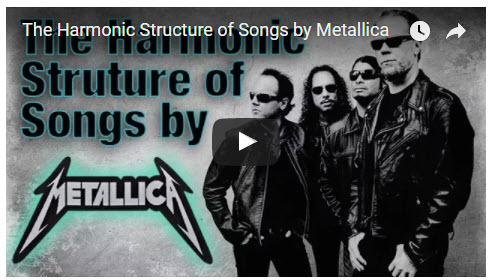Harmonic Structure in the Style of Metallica
Metallica’s music serves as a foundation for understanding much of the thrash metal that has followed in the past two decades.
Most of today's thrash bands cite Metallica as a major influence that has significantly shaped their sound. This post explores the harmonic mayhem that is Metallica...
WATCH THE VIDEO LESSON:
RIFFS:
To better understand the harmonies used by Metallica we need to begin by making sure that we understand the world of riffs. When single-note lines create “melodies” that are strong enough to stand on their own, and also serve as accompaniment patterns, a riff is born.
Metallica have a vast library of riffs with their tonality firmly rooted in Minor. The Natural Minor scale is the basis for constructing over 90% of Metallica's riffs, as well as, their guitar solos.
In order to be able to develop songs in the style of Metallica, a complete understanding of the Minor tonalities use in the creation of riffs is an absolute must.
THE TONALITY OF METALLICA:
Minor key tonality is the bed-rock of the Metallica sound. This means that the harmony for minor key sound is critical to understand. In example one, I've organized a standard "E Natural Minor" scale harmony.
Example 1). Harmonized "E Natural Minor" key center (Aeolian Mode)
One of the primary key signatures used by Metallica is the key of "E Minor." Metallica’s music is most notably characterized by its song structures that apply heavy "low-ended" registers, composed of long strings of riffs that surround the vocals.
In order to comprehend the way that Metallica applies these sounds, we need to better understand the form of how Metallica writes their music in the minor key center.
SONG STRUCTURE:
The Metallica song structure is much more elaborate than most pop songs, primarily because of their use of extended introductions, transitions, and instrumental solos (lead breaks).
This means that the listener needs to trace the large-scale progression inherent in the song structure in their mind as they listen. Metallica occasionally forgoes the return of the A-section and instead expands the B-section significantly (AAB’). This is found in the songs, “Fade to Black,” “Welcome Home (Sanitarium),” and “One."
Example 2). Sanitarium Riff (E Minor /Dorian)
click on the above image to enlarge full-screen
The typical Metallica A-sections will include a basic verse-chorus rotation with a brief two or four measure transition between verse and chorus. These transitions are not always formed around a complete riff but instead consist of a motive from the verse riff (riff a’).
The B-section of “Motorbreath” is a nice example of this. It is simply an instrumental passage with one lead break and no bridge. The lead break is supported by a new riff. The introduction of new riffs at the B-section of Metallica songs is not uncommon.
If an interlude is used, it will often follow the chorus and will be composed of an idea that is a completely unique riff.
To get a good idea of how Metallica lays out their song sections let's break down "Motorbreath."
Example 3). Motorbreath - Verse
Example 4). Motorbreath - Chorus
Example 5). Motorbreath - Interlude
It is clear that the style of riffs composed for use in a typical Metallica song are the primary building blocks of Metallica’s music, style and their overall sound.
What is of particular interest is how each Metallica riff is generally quite unique and tends not to function as constant variations of other song parts, (like we'd tend to find in a pop song). Instead, each riff used in one of their songs, is a more self contained style of riff.
Rather than using riffs that are simply derivatives of another riff, each transition in a Metallica song (from verse to chorus to interlude), will tend to offer the listener a unique riff idea that leads the listener away from the form of the song into another sound that is unrelated to the song’s other riffs.
CHORD TYPES:
The primary chord type used in songs by Metallica is the power-chord. This chord concept is a simple structure that only consists of the root and fifth. In some cases an extended reach up to the octave is included with this shape. It is evident in the song structure example shown above from the song, "Motorbreath."
Example 6). The Power-Chord (The perfect 5th interval)
Other chord types are also applied in various Metallica songs, which can include everything from basic major and minor open position chords and dominant 7th chords, (as found in the song "Nothing Else matters"), and some arpeggiated ideas found in their riffs that tend to include other chord types as well, (as used in songs like "Fade to Black').
Example 7). Nothing Else Matters
Example 8). Fade to Black
CONCLUSION:
Aside from a clearly present tonic function (generally as Minor tonality), across most of Metallica songs, the overall harmonic ideas presented in their music does not follow in the traditional form of pop and rock music. In fact, many of the standard rock, pop and country song harmonic structures are not even applicable in Metallica’s music.
While utilizing classical tonic, pre-dominant, and dominant harmonic procedures in certain circumstances, Metallica’s music tends to more often than not appropriate blues harmony functions.
This is demonstrated most often by a IV-I closing gesture, (often referred to as a plagal cadence). This Plagal function is quite evident in the verse riff of songs like “Master of Puppets.”
Another familiar approach found in Metallica’s music is a concept used commonly in Western classical music, which is the, I-VII-VI-V harmonic progression.
This progression is common partly because Metallica almost always prepares the dominant by descending step-motion, even if only by a single upper neighbor. This results in a significant lack of pre-dominant function outside the VI chord. The II chord never functions as a pre-dominant and a move to the dominant from the IV chord, a frequent event in classical music, is used sparingly.
On a final note, the flatted-second scale degree occasionally functions harmonically, even though it usually functions melodically (generally in a lead by Kirk Hammett), as a chromatic upper-neighbor or passing tone to the tonic.
When it functions harmonically, the b2 most often is juxtaposed against the tonic in a manner that suggests either the Phrygian or Locrian mode. A variation of the chorus riff found after the lead break of “Harvester of Sorrow,” highlights this function.
___________________________________________________
GET GOOD NOW - JOIN THE MEMBERS AREA















